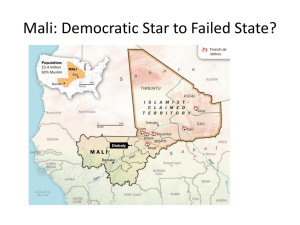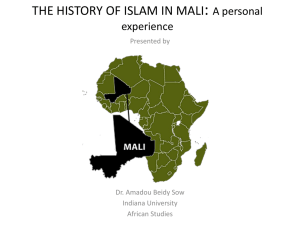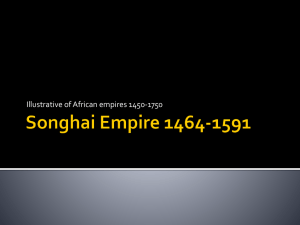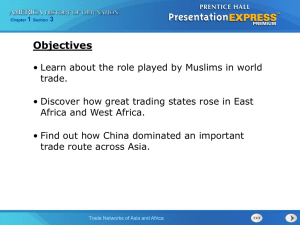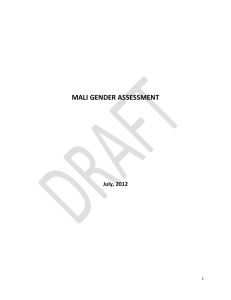Assignment 7
advertisement
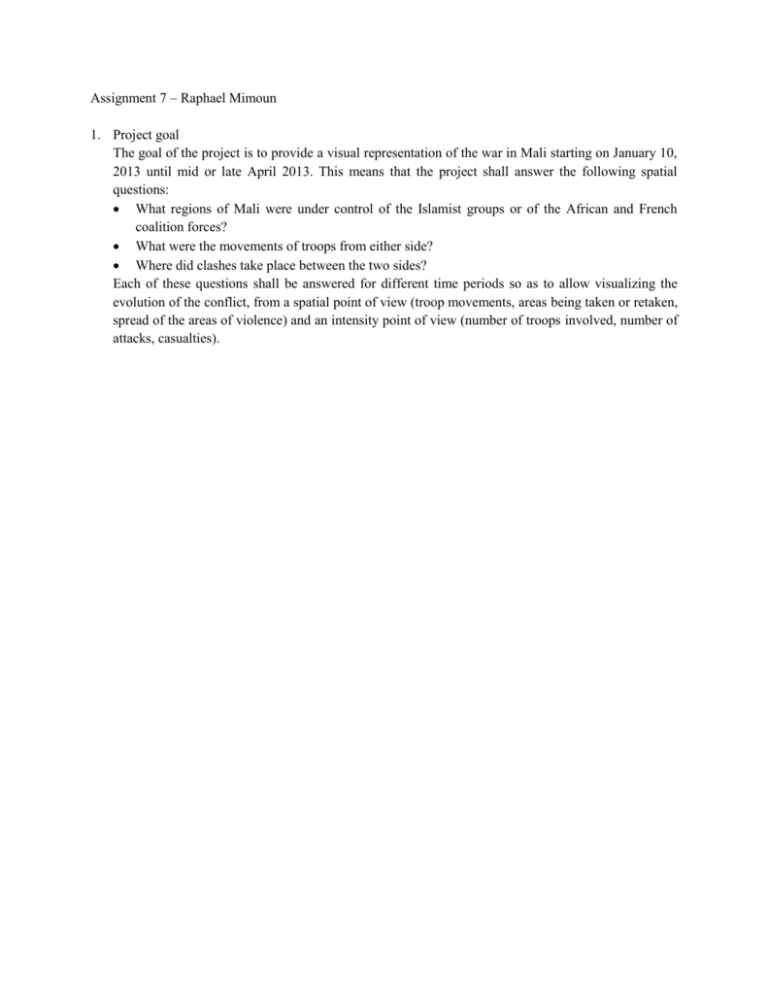
Assignment 7 – Raphael Mimoun 1. Project goal The goal of the project is to provide a visual representation of the war in Mali starting on January 10, 2013 until mid or late April 2013. This means that the project shall answer the following spatial questions: What regions of Mali were under control of the Islamist groups or of the African and French coalition forces? What were the movements of troops from either side? Where did clashes take place between the two sides? Each of these questions shall be answered for different time periods so as to allow visualizing the evolution of the conflict, from a spatial point of view (troop movements, areas being taken or retaken, spread of the areas of violence) and an intensity point of view (number of troops involved, number of attacks, casualties). 2. I. Burgess, J. et al, 2011, Map of the Rebellion in Libya, Day by Day, The New York Times, [online] 29 April, Available at: http://www.nytimes.com/interactive/2011/02/25/world/middleeast/map-of-how-the-protestsunfolded-in-libya.html This work was essentially the reason that motivated me to learn more about GIS. It allows visualizing very easily the evolution of the fighting in Libya in the 2011 civil war and the impact of the UN-backed military intervention on the course of the war. Thus, we see clearly the initial victories of the rebels, until the launch of a successful offensive by the Gadhafi forces starting on March 6; these forces seemed to be on their way to reconquer the whole country, retaking city after city towards the East in particular, until the launch of strikes by the US, France, and the UK on March 17, which reversed the course of the war eventually leading to a rebel victory. This fairly simple GIS presentation clearly supports the claim that, despite the UN mandate authorizing measures to protect civilians, the foreign intervention served as “an air force for the rebels”. II. Stephenne, N et al, 2009, Analyzing Spatial Drivers in Quantitative Conflict Studies: The Potential and Challenges of Geographic Information Systems, International Studies Review, [online] Available at: https://irevolution.files.wordpress.com/2009/09/fulltext.pdf This peer-reviewed article was particularly helpful in introducing the different concepts important to GIS mapping when applied to conflicts. In addition, a number of interesting quantitative and spatial indicators in the existing literature could prove useful if I focus on the underlying reasons for the conflict. These include: ethnic, economic and social fractionalization, presence of resources, etc. III. Daniel, S., 2013, French-led forces retake key north Mali town, AFP, [online] 27 January, Available at: https://www.google.com/hostednews/afp/article/ALeqM5hej852c76v5QA28TKEEUTx9l1f2Q?d ocId=CNG.76fbd3592ba9463cc1fb0afeabcb27cc.281 This news article is representative of the ones I would use in my project: it gives the position of troops, their movements and actions, and importantly what country their belong to. These are crucial information to understand which country is on the frontline battling the Islamist groups and which stays back to secure retaken areas. IV. 2013, Map of the War in Mali, Le Monde, [online] 16 January, Available at: http://www.lemonde.fr/afrique/visuel/2013/01/16/a-map-of-the-maliancrisis_1818035_3212.html This map, produced by a French newspaper, essentially represents the kind of map I am looking to produce in my project. However, it only concerns a six-day period, while my study will focus on at least three months. In addition, some data that I will include (nationality and numbers of troops involved) are not represented on this map. V. Data layers to be used: Name World Shaded Relief Cities of Mali Villages of Mali Regions of Mali Troops Clashes Description This map portrays surface elevation as shaded relief The dataset represents the towns of Mali (capitals and others). Data type: points The dataset represents the whole localities of Mali (towns and villages). Data type: points The dataset represents the regions of Mali. Data type: areas (polygons) This dataset represents the location and nationality of the troops involved in the conflict Data type: points This dataset represents the location and nature of clashes throughout the conflict. Data type: points Source URL if applicable ESRI Available from ArcGIS Online Government of Mali cod.humanitarianresponse.info/countryregion/mali Government of Mali cod.humanitarianresponse.info/countryregion/mali Government of Mali cod.humanitarianresponse.info/countryregion/mali Compiled by myself Compiled by myself VI. Expected data creation, processing, and/or analysis steps: I. Data collection: the core of the project will be the creation of the two databases on (1) the location and movements of troops and fighters and (2) the nature and location of violent events between the different parties. This process will involve going through the news coverage, day by day, of Malian, French and international sources to find the most accurate information. II. Once the data has been collected, I will have to convert the location from the name of towns or regions to coordinates. This may be challenging as in many cases, I expect the information to be limited to vague location between two villages. In some cases, I will therefore have to approximate the location, but this should not be detrimental as the project will be based on a nation-wide view. III. I will then create the basemap of Mali to be used throughout the whole project. This map will include: - ‘shaded relied’ - a certain number of cities of strategic importance for the project (selected from the layer ‘settlements’) and their names - the political boundaries of Mali and of the surrounding countries - the names of the surrounding countries IV. The data will then be imported into ArcMap onto the map of Mali. A different map will be created for each time period considered. The time periods will be either one day, when, for example at the beginning of the offensive, there were very quick developments, or one week for the later stages of the conflict. Each map will show - The area under rebel control and the area under governmental control (in two different colors) - The location, nationality and size of troop gatherings (the nationality will be reflected in the color of the symbol, and the size of the gathering in the size of the symbol) - The location, nature and intensity of violent clashes (the nature will be reflected in the symbology, with different symbols for fire fights, air strikes, and suicide bombings; the intensity will be reflected in the size of the symbols depending on the overall casualties) 5. I am not sure a poster would be the best way to present my project. If I can identify 5 to 6 different phases to the war, then I may decide to print a poster. If many more different phases are to be found, the final product shall be on a computer to allow to move between the different time periods and see the evolution of the war. In both cases, however, will be included: - The maps showing the location of troops and clashes - Two bar graphs showing the number of troops involved, with a breakdown by nationality, and the number of casualties - A text box providing a short background and useful information on the war


